Victorian Cookbooks Were Stuffed with Costumed Roosters and Sphinx Cakes
An “artistic centre piece for a supper table.” If you’re interested in re-creating this masterpiece: “Neptune, dolphins, horses, moulded in tinted fat. Car either natural shell or of fat. Falling water in tinted fat on plaster foundation. Coral in coloured fat. Lobsters, crayfish, salmon forcemeat fritters laid on brown fat rocks.” (All Photos: Courtesy New York Academy of Medicine)
When The Encyclopedia of Practical Cookery was published in England in the 1890s, Queen Victoria had been the reigning monarch for more than 55 years. It was an age of domesticity: Eliza Acton also published her Modern Cookery for Private Families, which sold briskly and introduced some of the conventions of today’s cookbooks, like measurements and cooking times, and Mrs Beeton’s Book of Household Management followed, remaining a best-seller for some 50 years.
So the timing must have felt right to release the eight-volume Encyclopedia. It was a comprehensive, detailed cookbook, with contributions from no fewer than ten chefs de cuisine and confectioners. It was ambitious in scope–the frontispiece states it is ”a complete dictionary of all pertaining to the art of cookery and table service,” containing recipes for all types of occasions, including “ball suppers, picnics, garden-party refreshments, race and boating baskets”.
In many respects, the format of the Encyclopedia is recognizable. It contains recipes, illustrations, and descriptions of food. Sometimes the measurements are more poetic than accurate: a recipe for “broad beans and cream” calls for “a lump of butter the size of a fowl’s egg.”

Intricately designed “artistic gateaux”. Note the sphinx ornaments on the bottom left “Egyptia Gateau”. According to the Encyclopedia, “there is no other class of culinary goods in which the ingenuity and skill of the cook, pastry-cook or confectioner finds more scope for practice than in making and decorating cakes.
It also contains recipes that would be rare for today’s home cook. Black pudding, a type of blood sausage, makes up a detailed half a page of the book; step one is “obtain a supply of large pig’s entrails.” It’s also an insight into the storage of fresh produce at the time: because of the two quarts of pig’s blood required, the Encyclopedia states it is essential to make blood sausage only on the same day that the animal is slaughtered.
The section on beverages may seem familiar in this holiday season:
“By a provision of man’s own ingenious construction, so many tasty liquors have been invented by himself to tempt his wavering thirst, that cases are not unknown in which his daily food abounds in the liquid form.”
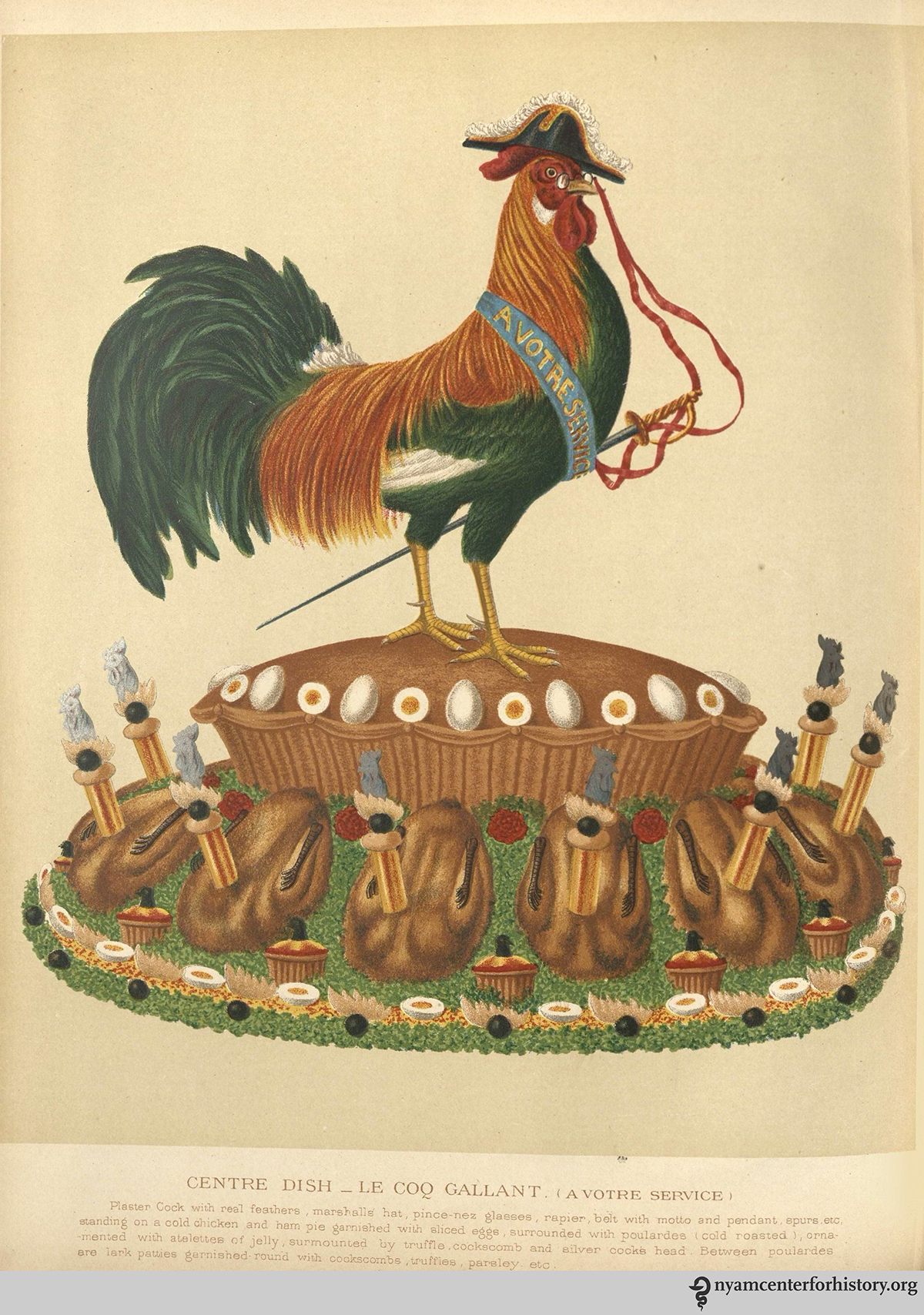
Another center dish, called “Le Coq Gallant”: “Plaster cock with real feathers, marshalls hat, pince-nez glasses, rapier, belt with motto and pendant, spurs etc, standing on a cold chicken and ham pie garnished with sliced eggs, surrounded with poulardes (cold roasted), ornamented with atelettes of jelly, surmounted by truffle, cockscomb and silver cocks head. Between poulardes are lark patties garnished round with cockscombs, truffles, parsley, etc.”
The recipes are punctuated by a number of lavish illustrations. Some are merely demonstrative–different types of cheeses or decorations for “picnic cakes.” Others show more elaborate table decorations that clearly fall outside the realm of “practical cookery”: a centerpiece of seafood crowned with King Neptune, trident aloft, or a plaster rooster wearing a pince-nez and a hat.
Thanks to the New York Academy of Medicine, which holds the Encyclopedia in its collection, today we are able to glimpse how people cooked and ate in the late 1800s. As we head into the most gluttonous time of the year, feast your eyes on these remarkable illustrations.
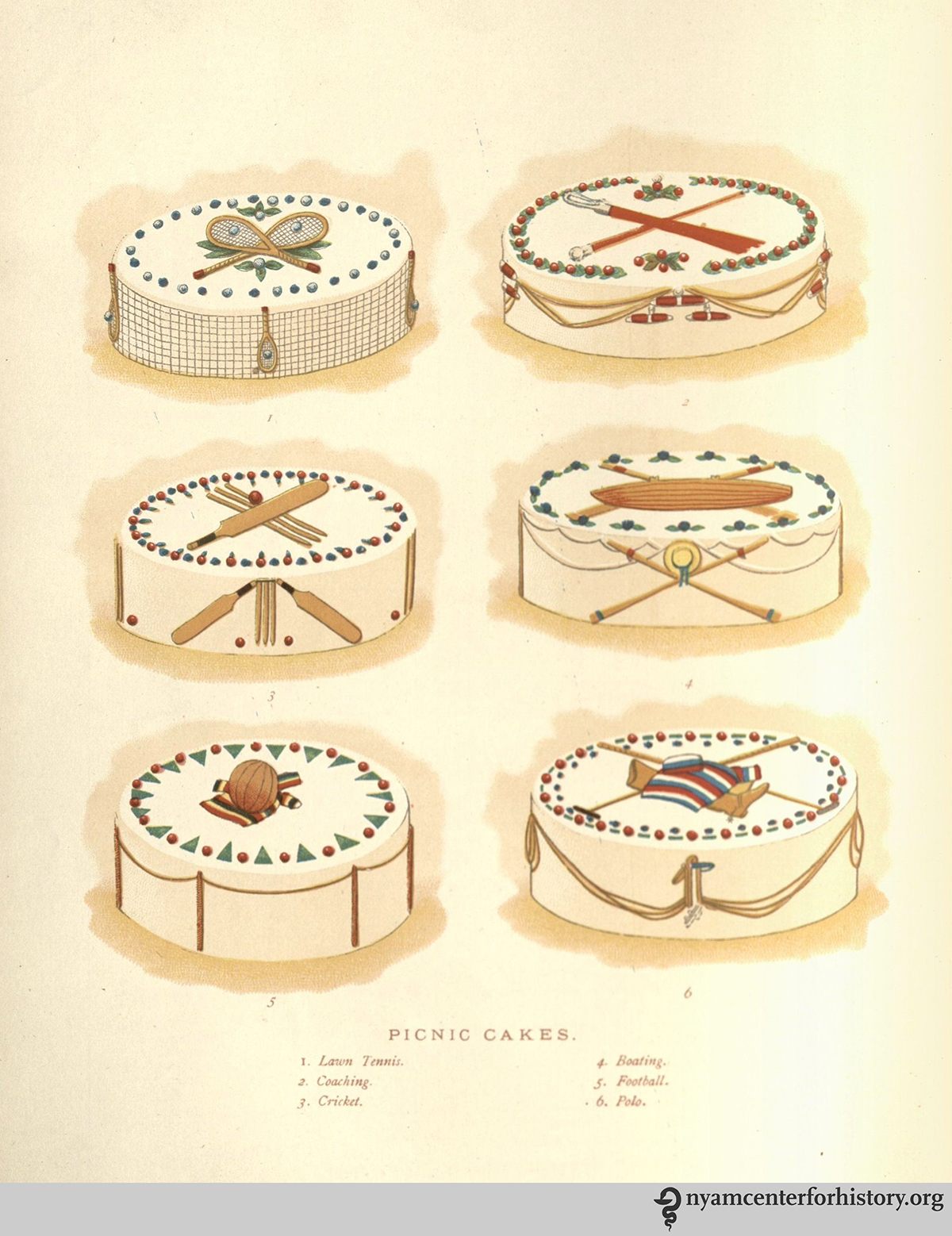
Types of “picnic cakes”: Lawn Tennis, Coaching, Cricket, Boating, Football and Polo.
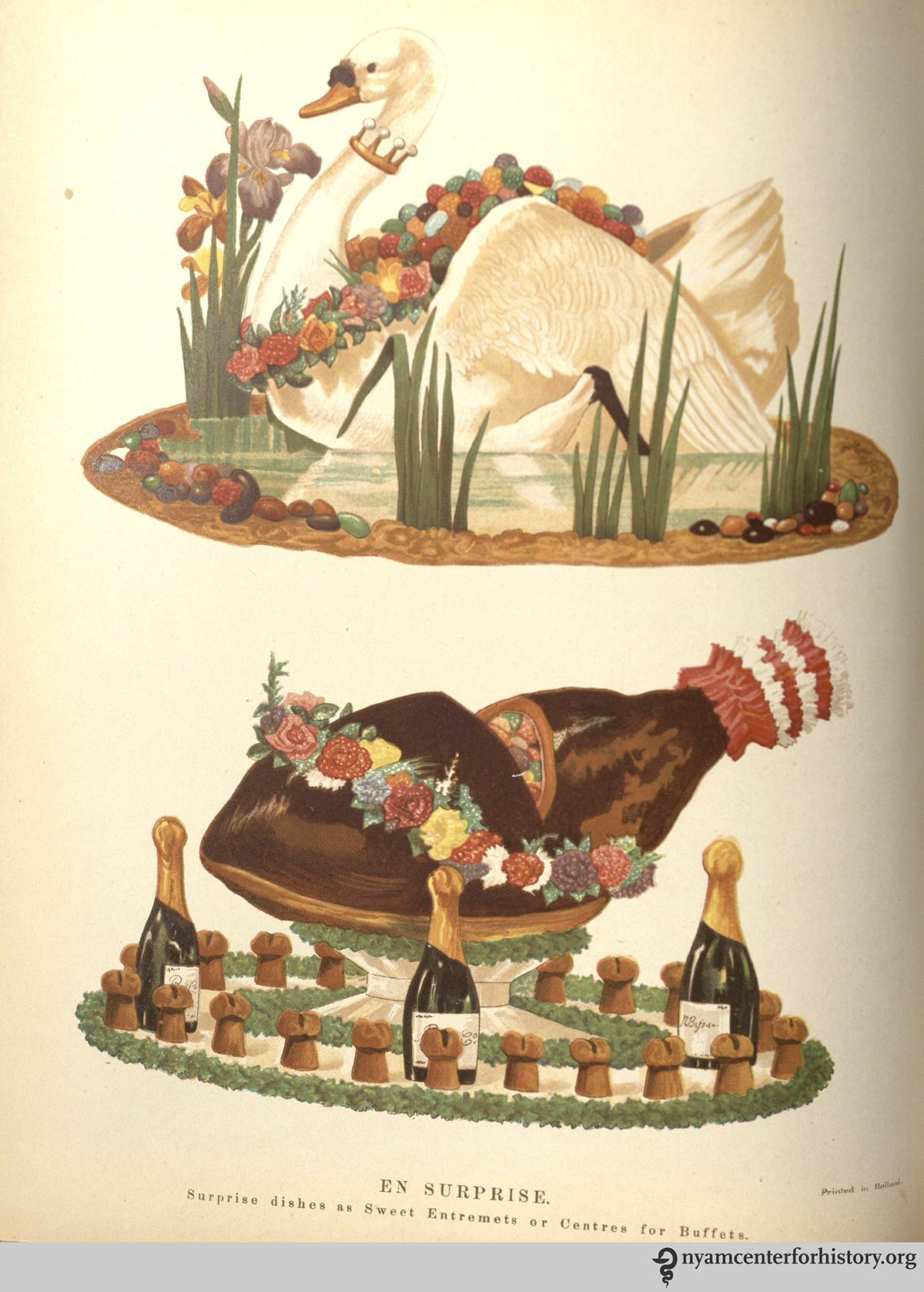
“En Surprise”, described as “Surprise dishes as Sweet Entremets” - that is, a dish served between courses - or as centers for buffets.

Different ways to carve poultry.
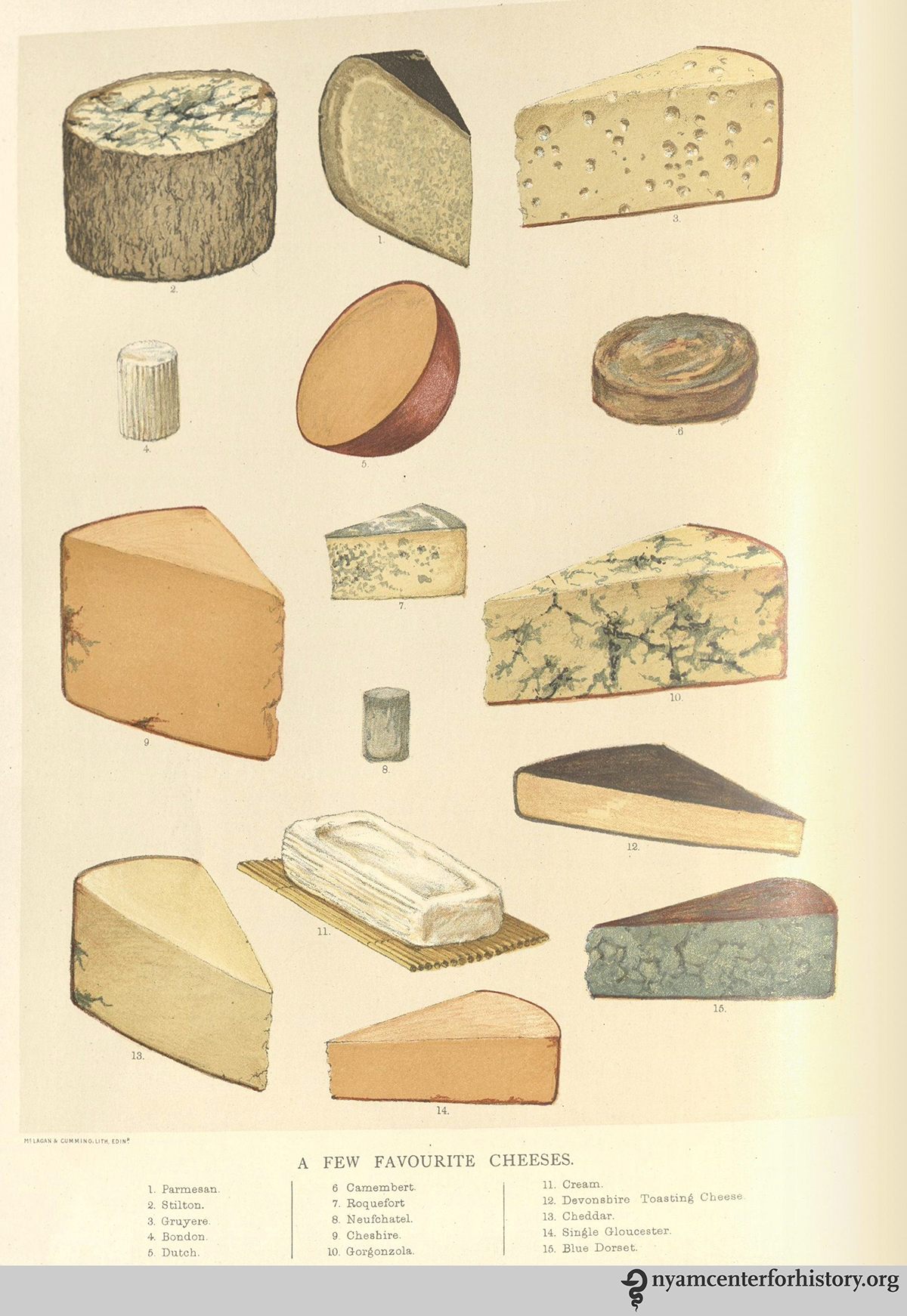
“A few favourite cheeses.”

Illustrations of “artistic dessert dishes”. The large dish in the center is “Gilt Rustic Wood Centre, Ornament for Mixed Fruit”, which “anyone with a little taste and ingenuity can make.”

Illustrations of “Fish Removes”: Cod à l’Anglaise, Sterlet à la Royale, and Mediterranean Mullet in Jelly.
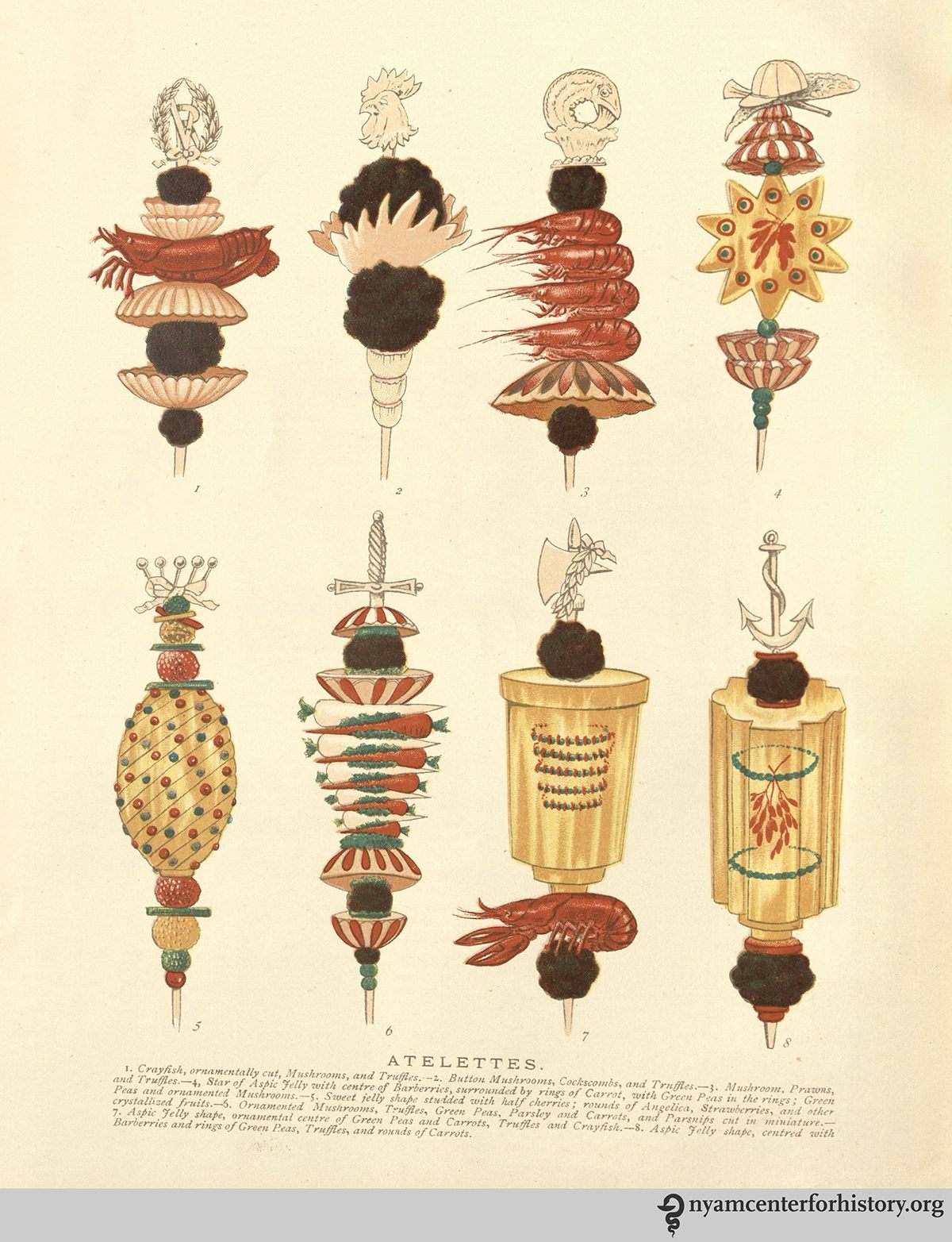
“Atelettes”, skewered food, including crayfish, mushrooms and aspic jelly.

Another elaborate “artistic centre piece”: “The stand is moulded in fat on a plaster base. The top stage is supported by swans and carries a wreath of larks and snipe, the latter with beaks in the air and turned truffles threaded on their beaks. The second stage or base consists of swans bearing dishes of truffles on their wings, and a wreath of quails and woodcocks quaintly trussed with mushroom tops threaded on their beaks. Carnations and other flowers complete the design.”

“Artistic arrangement for dinner table”, complete with garlands of flowers and a fountain.

A “modern ball buffet.” On the subject of “ball-suppers and refreshments”, “however exquisitely the room may be decorated, however sweet the music and highly polished the floor, and however charming and fascinating the company may prove, all is lost and absorbed in the discontentment bon of a badly-served or ill-provided supper.” The large amount of shrubbery in the background is deliberate: “…in the case of the buffet, as the maid-servants and the wall only, and perhaps a few piles of empty plates, glasses and other paraphernalia, are visible behind, it will be in perfect taste to lay it with a sort of background of noble epergnes, ferns and foliage plants…”

A “Wedding Breakfast Table.” The Encyclopedia has alot to say about decorating a table for a Wedding Breakfast. “Considerable skill may be exercised in the arrangement of the Wedding Breakfast and the decoration of the table, but the avoidance of all tall dishes, excepting a central piece and the cake, ought to be studiously observed. Flowers are indispensable, but should not be raised more than a few inches from the cloth. Scrolls and wreaths of flowers paid upon the cloth and curled round and about in pattern between the dishes, have the most charming appearance…”
Gastro Obscura covers the world’s most wondrous food and drink.
Sign up for our regular newsletter.




























Follow us on Twitter to get the latest on the world's hidden wonders.
Like us on Facebook to get the latest on the world's hidden wonders.
Follow us on Twitter Like us on Facebook